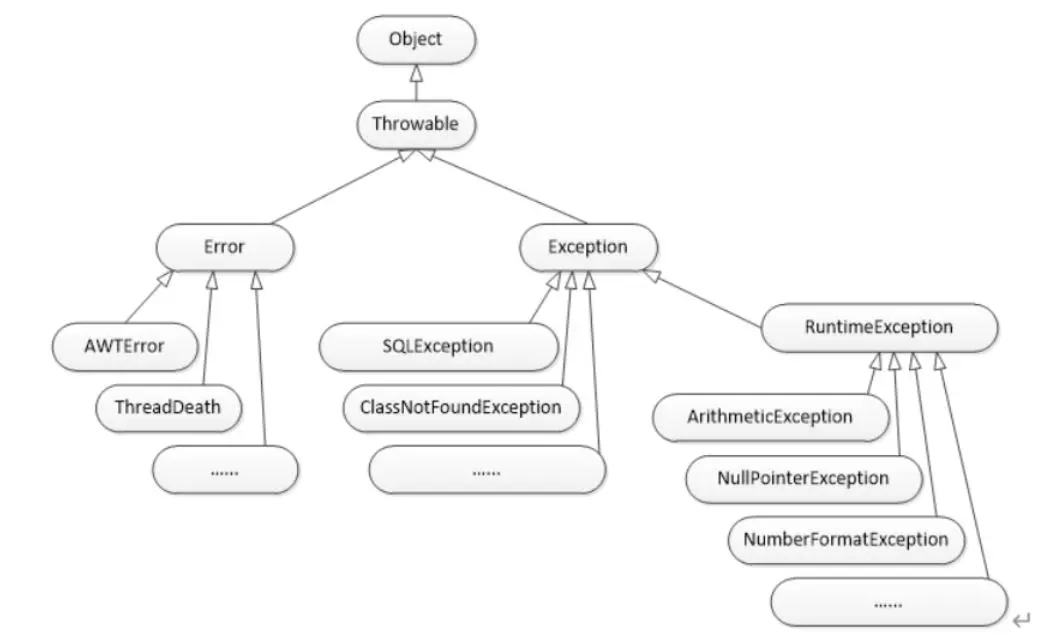
一、异常(Exception)
1. 引入:
什么是异常:
public static void main(String[] args) {
int i=1,j=0;
int sum = i/j;
System.out.println(sum);
}
上面的代码,在写的时候没有什么问题,但是点击运行,就会报出这样一段结果:

因为j是为0的,不能作为除数,点击运行就出现了算数异常。
另一种情况:

这种在我们写代码时出现的红色下划线,它向我们提示
Unhandled exception: java.io.FileNotFoundException
当前的代码可能会出现找不到文件的异常
2. 什么是异常:
异常是Exception,是程序的运行期间发生了不寻常的事情。
异常可以通过编写人员编写程序解决的。
3. 为什么要处理异常:
如果我们不处理掉异常,那么程序就不能正常的运行,因此我们需要处理掉异常。
4. 异常的两种情况:
由引入我们知道,异常是有两种情况的,分别是:
-
编译时异常(也叫做checked异常):checked异常即是受检查的异常,在编译过程中,如果没有被catch或者throws关键字处理的话,就没有办法通过编译
-
运行时异常(也叫unchecked异常):是在运行期间发生的异常。
Runtime Exception 运行时异常。
unchecked异常即是不受检查的异常,在编译过程中,我们即使不处理也能正常通过编译,但是在运行时会报出异常。
RuntimeException及其子类都统称为非受检查异常,常见的有:-
NullPointerException(空指针异常) -
IllegalArgumentException(参数异常,比如方法传入参类型异常) -
NumberFormatException(字符串转换为数字格式异常,IllegalArgumentException的子类) -
ArrayIndexOutOfBoundsException(数组越界异常) -
ClassCastException(类型转换异常) -
ArithmeticException(算术异常) -
SecurityException(安全异常,比如权限不够) -
UnsupportedOperationException(不支持的操作异常,比如重复创建同一用户) - ……
-
5. 怎么处理异常
异常处理的两套办法
- 使用try-catch-finally
- 使用throw-throws
使用try-catch处理异常
try块中存放可能发生异常的代码
catch块存放处理 异常的代码
当try块中发生异常时,程序立即跳转到catch块运行,catch块的作用是捕获异常,当异常被捕获以后,异常就没有了,所以程序就可以继续运行了。
如果try块中没有发生异常,那么程序就不会进入catch块。
public static void main(String[] args) {
File file = new File("d:/abc.txt");
FileOutputStream fs = null;
try {
fs = new FileOutputStream(file);
} catch (FileNotFoundException e) {
e.printStackTrace();//将异常捕获,则不再继续抛出异常
}
}
使用try-catch-finally处理异常
public static void main(String[] args) {
File file = new File("d:/abc.txt");
FileOutputStream fs = null;
try {
fs = new FileOutputStream(file);
} catch (FileNotFoundException e) {
e.printStackTrace();
}finally {
System.out.println("finally");
}
}
在这段代码中,无论是否能找到文件,finally都能够运行,
这说明finally表示无论try中是否出现异常,finally都是要执行的。所哟程序执行的路径是
发生异常时:try-catch-finally
或者
不发生异常时:try-finally
那我们可以充分利用finally的特点
finally的作用是什么呢?finally的作用是用于回收系统资源,比如释放数据库连接,断开网络等。
此外,catch可以多次使用,没有先后顺序。
使用throws和throw处理异常
public static void main(String[] args) throws FileNotFoundException {
File file = new File("d:/abc.txt");
FileOutputStream fs = new FileOutputStream(file);
}
上面代码将异常通过throws关键字向外抛给了虚拟机处理,方法内就不出现异常
throw关键字可以自己主动抛出一个异常,我们可以借此解决一些日常问题,例如:如果记录学生成绩,成绩在0到100之间,超出100或者少于0都不符合我们的要求,这是我们可以用throw处理。
public static void main(String[] args) {
try {
input();
}catch (RuntimeException e){
e.printStackTrace();
}
}
private static void input()throws RuntimeException {
Scanner scanner = new Scanner(System.in);
System.out.println("请输入成绩");
int score = scanner.nextInt();
if (score>100 || scoreThrowable对象的常用方法
-
String getMessage(): 返回异常发生时的简要描述 -
void printStackTrace(): 在控制台上打印Throwable对象封装的异常信息
private String message;
public ExceptionAndError(String message) {
super(message);
this.message = message;
}
@Override
public String getMessage() {
return this.message;
}//重写父类getMessage方法
public static void main(String[] args) {
try {
input();
}catch (RuntimeException e){
e.printStackTrace();
System.out.println(e.getMessage());
}
}
在经过修改后,结果为:

二、 错误(Error)
错误的引入
public class Test {
public static void main(String[] args) {
method();
}
private static void method() {
method();
}
}

什么是错误
错误,Error,表示无法通过开发人员编写程序来解决的错误,称之为错误,错误相关的类都是以Error结尾的。
三、Error与Exception的区别
在 Java 中,所有的异常都有一个共同的父类 java.lang 包中的 Throwable 类。Throwable 类有两个重要的子类:
-
Exception :程序本身可以处理的异常,可以通过
catch来进行捕获。Exception又可以分为 Checked Exception (受检查异常,必须处理) 和 Unchecked Exception (不受检查异常,可以不处理)。 -
Error :
Error属于程序无法处理的错误 ,我们没办法通过catch来进行捕获,不建议通过catch捕获 。例如 Java 虚拟机运行错误(Virtual MachineError)、虚拟机内存不够错误(OutOfMemoryError)、类定义错误(NoClassDefFoundError)等 。这些异常发生时,Java 虚拟机(JVM)一般会选择线程终止。
【信息由网络或者个人提供,如有涉及版权请联系COOY资源网邮箱处理】







暂无评论内容